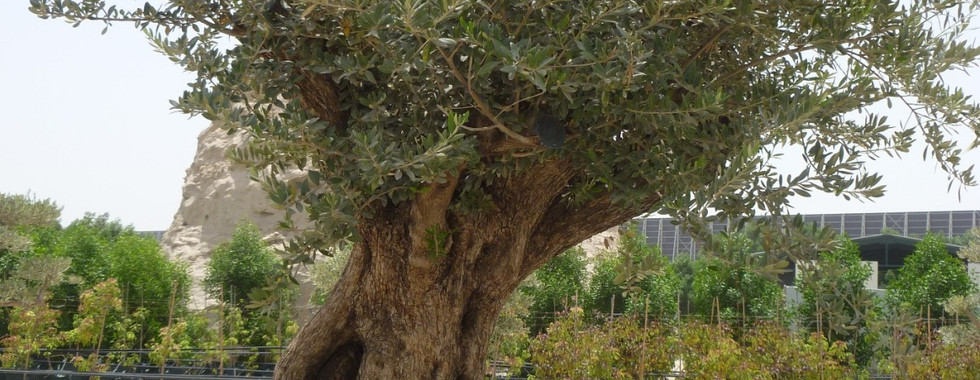Olives: An old favorite
- GardenMaestro
- Nov 25, 2023
- 4 min read
The domesticated, fruiting Olive (Olea europaea subsp. europaea) that we are all familiar with belongs to the genus Olea, of which there are well over 40 different species. These are dispersed over quite a broad range, stretching from the Mediterranean, through to China, and down through Africa; however, only one species is cultivated significantly for its fruit.
There is also a local native olive, Olea chrysophylla, which is endemic to the Arabian Peninsula but is quite scarce in nature and unfortunately not widely cultivated.
Olives are possibly one of the oldest commercially farmed fruits, and the history of this stretches back at least 7,000 years. The Olive also holds both cultural and religious significance for various groups and faiths, with the underlying associations of peace, hope, reconciliation, health, and fruitfulness shared by most.
While fruiting Olives are endemic to the Mediterranean, they happen to grow quite well in the GCC, and they make good feature/ specimen plants; they also make quite a good hedge, although they are fairly slow compared to other hedging plants, so are normally overlooked for this reason.
Sadly, very few Olive plants will actually produce fruit in the region. The predominant flowering time for Olives in the UAE corresponds with the hottest periods of summer. During this time insect activity is noticeably less, which means fewer pollinators; additionally, the high temperatures at these specific times lead to flower abortion. Occasionally, small green fruit will form, and then due to the temperature will simply drop off. Very seldom will you see an Olive tree with any significant amount of fruit on them, if any.
In the local market, you will find various ages of Olive plants, ranging from saplings to those with incredibly large and gnarled trucks, often sold as “ancient Olives”, with the prices normally mirroring the perceived age of the plant.
I want to now digress slightly onto the age of these “ancient” plants as well as the prices placed on these.
Normally when a plant has an imposing girth you can equate that to age taking into account the growth habit and physical location of the plant. With Olives, this is more difficult as they develop what is called a communal stem system. These start off as small lateral shoots at the base of the trunks, which grow up vertically adjacent to the main stem, over time they become integrated into the main stem through a process of natural grafting (however, they all share the same root system). As this happens all around the trunk overtime the girth of the trunk is increased by the separate stems being incorporated into the main trunk. In many instances, the main trunk at the center of the community of trunks may even die out, leaving the center of the tree hollow. This process of multiple, naturally grafted trunks gives old Olive trees their characteristic gnarled appearance.
This means you can’t simply date most of these trees by taking a core, as it is a combination of trunks, with the youngest on the outside and the older ones on the inside. Moreover, with very old trees, there is seldom (if any) any providence to verify when a particular tree was planted. The older trees that are found in the UAE market today are normally ones that have been lifted from old Olive groves in either Spain or Italy or plants that have been removed due to development. It should also be noted that both of these countries have restricted/ curbed the removal of these plants in recent years as they are now considered part of their “cultural history”. Someone with a reasonable amount of experience and with some information on the origin of the tree and climate could make an educated guess as to the age, but it would still be an estimate at best.
Now onto use in the garden
Olives are excellent plants for both the open garden as well as containers as they are easy to cut and make good topiary plants. They don’t have invasive root systems, but in a garden setting try to keep them at least 2 to 2.5 meters away from any wall, as they need space as they mature. They are able to take full summer sun in the UAE, although may look a little stressed mid-summer (depending on location), but will quickly bounce back during the winter. If the plants are in containers, try and keep them off of light-colored paving, and away from light-colored walls, glass surfaces or adjacent to swimming pools, as reflected light can cause them to burn. As a container plant be mindful of the height of the plant in relation to the container size; they are normally quite dense growing, so offer more surface area to wind, and taller plants can easily be blown over if the container is too small.
Olives tolerate a wide range of soil types, from sandy right through to loamy-clay soils, the soil type should dictate the frequency of watering, they prefer to be slightly dry and can develop root rot in poor-draining soils if over-watered.
Plants definitely benefit from regular applications of either organic or chemical fertilizers.
From a pest perspective, Scale insects are the biggest problem (and Mealy bug to a lesser extent), this normally occurs in plants that are located in areas of poor/ low air circulation, or plants that have very dense foliage (due to pruning).














Comments